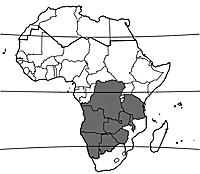Combretum celastroides (PROTA)
Introduction |
| General importance | |
| Geographic coverage Africa | |
| Geographic coverage World | |
| Carbohydrate / starch | |
| Medicinal | |
| Timber | |
| Fuel | |
| Auxiliary plant | |
| Climate change | |
Combretum celastroides Welw. ex M.A.Lawson
- Protologue: Fl. trop. Afr. 2: 422 (1871).
- Family: Combretaceae
- Chromosome number: 2n = 104
Synonyms
- Combretum laxiflorum Welw. ex M.A.Lawson (1871),
- Combretum patelliforme Engl. & Diels (1899).
Vernacular names
- Jesse-bush combretum, savanna bushwillow, trailing bushwillow (En).
Origin and geographic distribution
Combretum celastroides occurs in DR Congo, Tanzania and throughout southern Africa.
Uses
In northern Zimbabwe ash of the dried stem is mixed with white clay and applied to the face to treat conjunctivitis.
Combretum celastroides is highly valued as fuel wood and for charcoal production. It is also a source of wood for construction purposes. It is an important bee plant as it produces a lot of nectar.
Properties
Different leaf extracts showed anti-inflammatory activity, as well as some antifungal activity against Candida albicans, Cryptococcus neoformans, Aspergillus fumigatus, Microsporum canis and Sporothrix schenckii.
Description
Shrub, climbing or not, or small tree up to 12 (–20) m tall. Leaves (almost) opposite, simple and entire; stipules absent; petiole 2.5–20 mm long; blade narrowly to broadly elliptical or obovate, 2.5–14 cm × 1–8 cm, apex bluntly acuminate, base cuneate to rounded, papery to slightly leathery, glabrous to fairly densely short-hairy, especially on the veins beneath, with reddish, golden or silvery scales beneath, pinnately veined with 4–10 pairs of lateral veins. Inflorescence a terminal panicle, 5–15 cm long, and smaller spikes in the axils of the upper leaves. Flowers bisexual, regular, 4-merous, yellow to cream or whitish, sweetly scented, sessile, receptacle consisting of 2 parts, rusty red, scaly, lower receptacle 2.5–6 mm × 0.5–1 mm; sepals ovate-triangular, petals linear-elliptical, 1.5–2.5 mm long, stamens 8, up to 1 mm long, disk 2–5.5 mm in diameter; ovary inferior, 1-celled, style 2–3 mm long. Fruit a 4-winged nut, broadly ovoid to nearly orbicular in outline, 1.5–2.5 cm in diameter, stipe 0.5–2.4 mm long, rusty red or golden scaly, wings 6–10 mm broad, becoming bright red, fruit body remaining green-yellow, drying golden brown and shiny, indehiscent, 1-seeded.
Other botanical information
Combretum is a very large genus, comprising about 250 species distributed worldwide in the tropics and subtropics. About 140 species occur in tropical Africa. Another species with medicinal uses in the region is Combretum longispicatum (Engl.) Engl., which is endemic to Tanzania. The root is roasted and the cut end is applied to wounds to improve healing.
Ecology
Combretum celastroides occurs in open deciduous woodland and thickets, often on termite mounds, and riverine forest at 500–1700 m altitude. It is usually found on sandy soil or silt, and occasionally on copper-bearing soils. Its flowering and fruiting period varies depending on the region.
Propagation and planting
The germination rate of the seeds of Combretum celastroides is highly variable and ranges from 0–80%. The seeds should be removed from the fruit and soaked for a few hours before sowing. Germination takes place 10–21 days after sowing.
Management
Combretum celastroides can be coppiced.
Genetic resources
Combretum celastroides is widespread and rather common, and is therefore not threatened by genetic erosion.
Prospects
Combretum celastroides has few local medicinal uses, and it seems likely that it will remain of local importance only unless additional phytochemical and pharmacological research reveals interesting properties.
Major references
- Latham, P., 2005. Some honeybee plants of Bas-Congo Province, Democratic Republic of Congo. DFID, United Kingdom. 167 pp.
- Masoko, P. & Eloff, J.N., 2006. Bioautography indicates the multiplicity of antifungal compounds from twenty-four southern African Combretum species (Combretaceae). African Journal of Biotechnology 5(18): 1625–1647.
- McGaw, L.J., Rabe, T., Sparg, S.G., Jäger, A.K., Eloff, J.N. & van Staden, J., 2001. An investigation on the biological activity of Combretum species. Journal of Ethnopharmacology 75: 45–50.
- Neuwinger, H.D., 2000. African traditional medicine: a dictionary of plant use and applications. Medpharm Scientific, Stuttgart, Germany. 589 pp.
- Wickens, G.E., 1973. Combretaceae. In: Polhill, R.M. (Editor). Flora of Tropical East Africa. Crown Agents for Oversea Governments and Administrations, London, United Kingdom. 99 pp.
Other references
- Chilufya, H. & Tengnäs, B., 1996. Agroforestry extension manual for northern Zambia. Regional Soil Conservation Unit, Nairobi, Kenya. 120 + 124 pp.
- Eloff, J.N., Jäger, A.K. & van Staden, J., 2001. The stability and the relationship between anti-inflammatory activity and antibacterial properties of southern African Combretum species. South African Journal of Science 97(7–8): 291–293.
- SEPASAL, 2010. Combretum celastroides. [Internet] Survey of Economic Plants for Arid and Semi-Arid Lands (SEPASAL) database. Royal Botanic Gardens, Kew, Richmond, United Kingdom. http://www.kew.org/ ceb/sepasal/. December 2010.
Author(s)
- E.N. Matu, CTMDR/KEMRI, P.O. Box 54840–00200, Nairobi, Kenya
Correct citation of this article
Matu, E.N., 2011. Combretum celastroides Welw. ex M.A.Lawson. In: Schmelzer, G.H. & Gurib-Fakim, A. (Editors). PROTA (Plant Resources of Tropical Africa / Ressources végétales de l’Afrique tropicale), Wageningen, Netherlands. Accessed 31 May 2025.
- See the Prota4U database.

